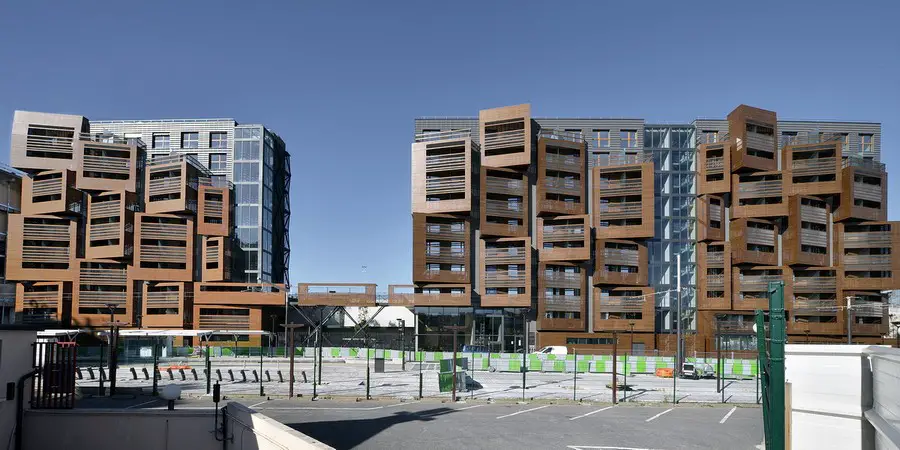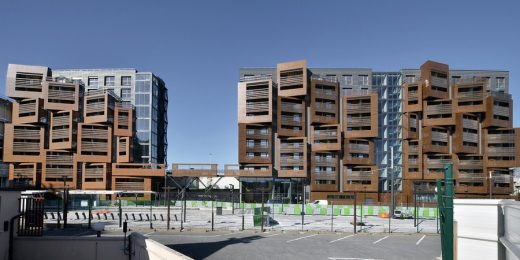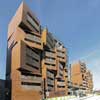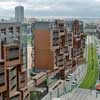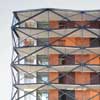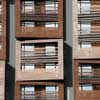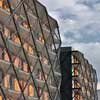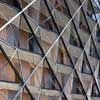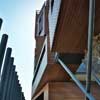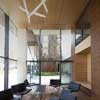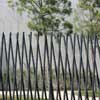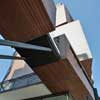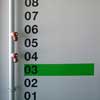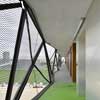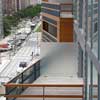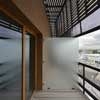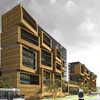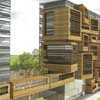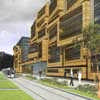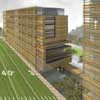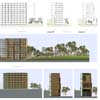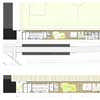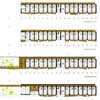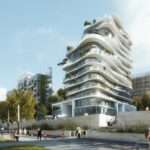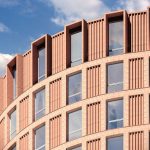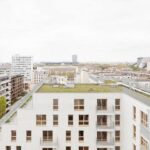Student Apartments Paris, Flats Design, Housing Images, French Residential Architecture
Paris Student Apartment Studios
19th District Building, France design by Ofis Arhitekti Architects
19 Feb 2013
Paris Student Apartments
‘Basket Apartments’
Design: Ofis Arhitekti, Slovenia
Basket Apartments in Paris
Urban plan condition
The project is located on a long and very narrow site, on the edge of Parc La Vilette in Paris’s 19th district, within an urban development done by Reichen & Robert architects. On the northeast, new Paris tram route is passing along the site. The site is bordering with tram garage on the southwest, above which is a football field. The first 3 floors of the housing will inevitably share the wall with the tram garage.
Site plan conditions
The parcel has a very particular configuration; 11m in width and extending approximately 200m north-south. This foreshadows the importance of processing the eastern facade overlooking the extension of the street, des Petits Ponts, which hosts the tram and both cyclist and pedestrian walkways.
Plot conditions
The long volume of the building is divided into two parts that are connected with a bridge. Between two volumes is a garden. The building has 11 floors: a technical space in the basement, shared programs in the ground floor, and student apartments in the upper nine floors. The layout is rational and modular.
Program – student dormitory with 192 studios
The major objective of the project was to provide students with a healthy environment for studying, learning and meeting. Along the length of the football field is an open corridor and gallery that overlooks the field and creates a view to the city and the Eiffel tower. This gallery is an access to the apartments providing students with a common place. All the studios are the same size and contain the same elements to optimize design and construction: an entrance, bathroom, wardrobe, kitchenette, working space and a bed. Each apartment has a balcony overlooking the street.
Design concept
Because of the narrow length of the plot, the façades have a significant presence in its surroundings. Each volume contains two different faces according to the site and the program:
The elevation towards the street des Petits Ponts contains studio balconies-baskets of different sizes made from HPL timber stripes. They are randomly oriented to diversify the views and rhythm of the façade. Shifted baskets create a dynamic surface while also breaking down the scale and proportion of the building.
The elevation towards the football field has an open passage walkway with studio entrances enclosed with a 3D metal mesh. Both volumes are connected on the first floor with a narrow bridge which is also an open common space for students.
Sustainable efficiency
The building is energy efficient to accommodate the desires of Paris’ sustainable development efforts. The Plan Climates goal is that future housing will consume 50KW-h.m.² or less. The objectives of energy performance and the construction timetable were met by focusing on a simple, well insulated and ventilated object that functions at its best year round.
Accommodations are cross ventilating and allow abundant day lighting throughout the apartment. External corridors and glass staircases also promote natural lighting in the common circulation, affording energy while also creating comfortable and well lit social spaces. The building is insulated from the outside with an insulation thickness of 20 cm.
Thermal bridge breakers are used on corridor floors and balconies to avoid thermal bridges. Ventilation is controlled by double flow mechanical ventilation, providing clean air in every apartment with an optimum temperature throughout the year. The incoming air also reuses heat from the exhaust air. The roof is covered with 300m² of photovoltaic panels to generate electricity. Rainwater is harvested on site in a basin pool used for watering outdoor green spaces.
Basket Apartments Paris – Building Information
location: 19th district, Paris, France
status: invited competition 2008 ; construction start 2009 ; completion 2012
program: student apartment studios, common spaces, dining area, living space, storage
details: low energy consumption building, 10 floor building with 192 studios
type: student housing
client: Regie Immobiliere de la Ville de Paris
area: site 1981 m2; size of studios 35 m2; building 931 m2; gross floor area 8500 m2; landscape 1050 m2
dimensions: 29,20 m max height
budget: 17M €
materials: concrete, glass, metal, plaster, high-density stratified timber panels, expanded metal mesh
project team:
Rok Oman, Spela Videcnik
Robert Janez, Janez Martincic, Andrej Gregoric, Janja del Linz, Katja Aljaz, Louis Geiswiller, Hyunggyu Kim, Chaewan Shin, Jaehyun Kim, Erin Durno, Javier Carrera, Giuliana Fimmano, Jolien Maes, Lin Wei
technical team:
Structural engineering: INTEGRALE 4; Bruno PERSON
Mechanical & electrical engineering, sustainable development: Cabinet MTC; Cyril GANVERT
Paris Basket Apartments images / information from Ofis Arhitekti
27 Nov 2008
Paris Student Apartment Studios Design
Student apartment studios on Route des Petits Ponts
Paris 19e
2008_invited competition- first prize
Design: Ofis Arhitekti, Slovenia
General Description
The project involves a dormitory with 180 studios on the site of the Stade de Ladoumague in Paris in 19th district. The plot of the building is part of urban development done by Reichen & Robert architects.
By early 2012, the Paris tram will pass by the site, and the goal is to complete the project before the opening in 2011. Another project goal is to achieve a building consumption with very little power, joining the desire of the city of Paris through its “climate plan”. The major objectives of the project is to design a home to accommodate students able to offer them a healthy environment for study, learn, have fun, meet … The building must be “energy efficient” and be built at the end of 2010. To achieve these objectives with energy performance and construction time table plan the focus was to design a simple, well insulated and ventilated object which will function at best during all seasons.
Route des Petits Ponts Apartments
Architectural, urban and technical proposal
The parcel has a very particular configuration; 11 meters in width and extends about 200 meters long in north-south axis, which foreshadows the importance of processing the eastern facade overlooking the extension of the street of small bridges (des Petits Ponts). In addition, this street will host the tram, a road cyclist and pedestrian walkways. The extension of the street of small bridges also leads to the Canal de l’Ourcq, hence the priority treatment landscaped plot to accompany this urban landscape.
In our case, it is not just a building to integrate into its environment but rather to integrate a piece of street, a facade composed of buildings and landscape.
The residence follows the urban plot which are two blocks divided by sharing landscape garden.
Both parts are organized according to a simple and functional frame for a logical and economic optimization. On ground floor are the lobby, the rooms, common areas opened over the course and some studios (accessible for the disabled). Upstairs are all studios and a terrace.
The plans are organized according to simple management and maintenance. Also the task was to provide students environment of indoor and outdoor quality with creating the meeting places in which each student can feel good and enjoy the indoor and outdoor landscape. Access to the residence is between the 2 buildings. For security and management reasons, there is only one entry. We used the system of horizontal flow; taking into account technical constraints related to sports complex vis-a-vis the main housing openings. The circulations are naturally lit and ventilated, and allowing East-West views.
Studios_concept_sustainability
The residence comprises 192 studios. Studios are accessible to disabled persons on the ground floor. All rooms are equipped with the same principle throughout the residence for better optimization.
There is also studio with two bedrooms on each floor. There are seven in total throughout the building, which used to meet expectations in terms of student housing for couples.
The concept key point is inside the studios: work on light and air quality and spaces.
The accommodations are crossing, allowing for natural light throughout the apartment. The design of housing was thought to offer comfort, brightness and functionality. The layout is rational and allows modularity. The apartments are mechanically ventilated with a double shift VMC.
The breakdown by VMC is much more economical and offers students an air and a healthy environment, necessary and vital for the smooth functioning of the individual. The majority of the studios have a unique outdoor space with loggias which are actually an extension of interior spaces. The loggias create intimate outdoor spaces and offer views of the surrounding neighborhoods.
In view of the targets on energy performance, thermal insulation and soundproofing of the building will be extra efficient. The isolation of the project is done by outside isolation 16cm thick, to reduce heat loss. This insulation thickness makes the building very well insulated, while opening large bay front to let maximum light into the apartments. This insulation is of course both thermal and acoustic proof.
The structure of the building next to the wall of the SMR is insulated to prevent heat transfer between the two structures, and of course acoustic insulation for the building site maintenance.
To avoid the problem of thermal bridges of balconies and loggias we integrate the structure of the elements of broken bridges thermal type SCHÖCK. It avoids thermal losses and especially sustainable balance investment costs over time.
The Elevations
The facades will have a major impact on environment because of the length of the plot. The eastern facade of the building looks towards the sport field, and is formed by main entrance gang. The eastern facade is composed of loggias covered in bamboo. They appear on the cover as wooden cocoons and are randomly oriented to diversify the views and rhythm to the facade. The arrangement of the elements creates dynamic surface and breaks the scale of the building at the same time.
The use of bamboo for the loggias has human scale and environmentally approach. The bamboo is environmentally friendly material. The loggias are equipped with bamboo sunscreens to control sunlight on the balconies and interior. Bamboo is also used on the western front as horizontal blade to manage the sunshine of the passageway. At the same time it protects the corridors from the sport field.
The climbing plants will be grown to serve as visual and environmental filters: In summer, the facade will be refreshed by the thickening of the filter plant and in winter the facade work normally, everything perfectly fits into the environment by creating seasonal facades.
The structural composition
The complex consists of two rectangular blocks. The first block dimensions are 30x11m and the second 65x11m. The overall building rises at 29.2 meters.
The building structure is reinforced concrete. Foundations are types of piles, 12 to 15m deep. They are connected by sills. The floors are rational and identical. They are made of reinforced concrete floors on the 2-way and are supported by walls and poles. Both parts of the building have its communication core which serves all floors. All the walls are reinforced with a thickness of 20 cm.
The landscape
the space between the two parts of the building will be used as a garden, which will have the same functions than Parisian court in function to shift from one building to another, for meeting and relaxation. It will be a common landscape, leaving a visual opening to the garden. The garden is accessible from outside access for fire site of the SMR (magnetic card or key).
The garden located north of the plot has more private character but also provides transparency with the street. It is used as a park on a small scale.
Covered in wood, it is a place of relaxation and calmness for students. This may be a place of rest or work. The garden is arranged in levels to respond to the work of art that will be seen from the tram, but also to collect views from the Canal de l’Ourcq or the surroundings with a panorama in altitude.
All green spaces (common and technical) are equipped with automatic sprinkler dropper, which requires less maintenance manager of the residence and consumes much less water.
Accessibility for the disabled
The building was designed to accommodate also disabled people and provide them the best environment. The residence includes more than 10% of homes directly accessible for the disabled (23 units). These accommodations are arranged on ground floor and first floor for easy access and proximity to allow common areas, facilitating the social integration of individuals with reduced mobility.
Paris Student Apartments – Design Team
Architects: Rok Oman, Spela Videcnik, Robert Janez, Katja Aljaz, Andrej Gregoric, Javier Carrera
Consultants:
Structural Engineering: Matjaz Pilic – Elea IC
Mechanical, Electrical Engineering & Sustainability: Menerga d.o.o.
Paris Student Apartment images / information from Ofis Arhitekti 271108
Location: des Petits Ponts, Paris, France
New Paris Architecture
Contemporary Paris Architecture
Paris Architecture Design – chronological list
Architecture Tours Paris by e-architect
ZAC du Port Housing, Pantin, northeastern suburbs of Paris
Architects: AZC and SPLAAR
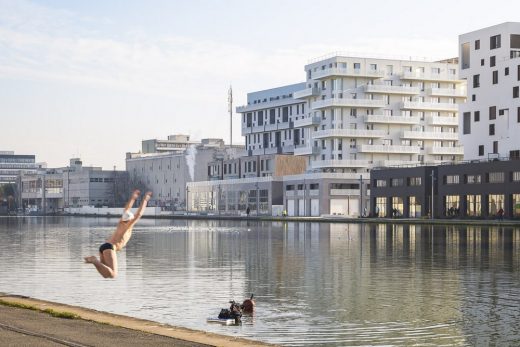
photo: Sergio GRAZIA
New Housing in Pantin
104 Social Housing and Home Ownership, Ivry-sur-Seine
Design: Engasser & associates agency
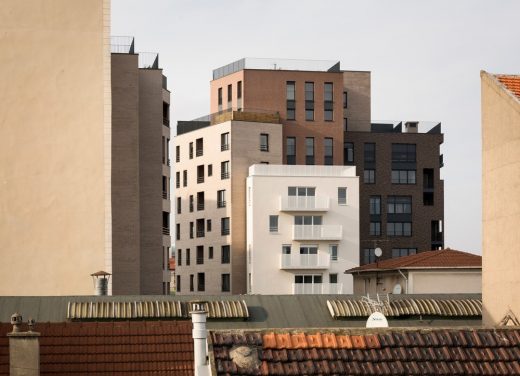
photographe : Mathieu Ducros/Michel Denancé
New Housing in Ivry-sur-Seine
Herold Apartments
Jakob+MacFarlane Architectes
Herold Apartment Buildings
Buildings / photos for the French Student apartment studios – Paris 19th District Apartment Building page welcome

